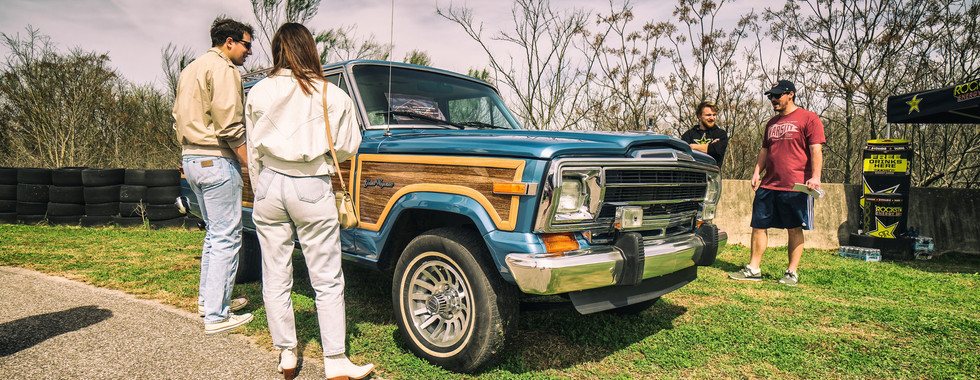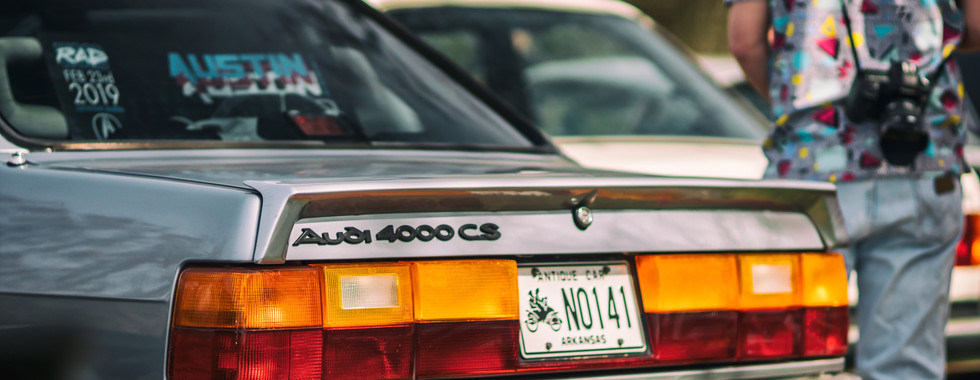The Fastest Way from Dallas to Austin is Craigslist: A Radwood Story
- Editor

- Nov 17, 2019
- 8 min read
Updated: Feb 12, 2020


I reckon you could write a fair criticism of Radwood if you approached it from an angle of indulgent nostalgia. It’s not a difficult association to make on its face. The soundtrack, the attire, all of it, if you allow, working to orchestrate a tsunami of the most politically and economically nauseating phrase known to humankind: “simpler times”. Anything that harkens back to the ignorance of anyone’s youth makes me suspicious these days, which, given our generation’s earned cynicism, doesn’t seem entirely unreasonable. I don’t like the remakes and FM country music I once used to consume: it didn’t take too many months into adulthood to figure out pandering and updating the visual effects on established stories is a keyboard shortcut to low-effort cash flows.
My parents’ generation did this with the 1950s back in the 1980s. Pop culture seems to always discover a box full of photo albums in the attic that have got 30 years of dust on them before bringing them down, brushing them off, and spending the next decade extolling the cultural virtues and artistic accomplishments one generation removed. It all feels so…recycled.

So, when I tell you that Radwood is the most shameless, glimmering fun I’ve had doing something car related maybe in my adult life – which, for context, includes being raised in a household with car enthusiasts, baptized, inundated, and indoctrinated with car culture at most waking moments – I’ll grant you full permission to call me a sell-out. I’m entirely uncertain what string of obscenities and shame you will want to smother me with when you discover that when my own Radwood-eligible vehicle opted to ventilate a head gasket less than a month before the show my desire to partake in the full experience was so strong that, along with a similarly afflicted individual, we bought a BMW 7-Series for $0.31/pound.
But hear me out here: Radwood isn’t just this excuse to don a mullet wig, fuel up your automotive irony, and head out to a racetrack in suburban Austin just past the acres of urban cooperative farming stereotypes. Believe me, I’m mad at myself for having to admit it’s given me some new perspective to understand the Boomer obsession with the Eisenhower years. I’ll beg your forgiveness another day, because Radwood made me feel something that I wasn’t sure I could feel as a post-recession Millennial:
Optimism.
But first, I should address how we arrived.

The most grave danger in becoming a married adult human car enthusiast lucky enough to enjoy two incomes, two dogs, zero kids, and just enough patience from the rational side of the relationship to get away with something monumentally stupid is having the sudden, grotesque realization that you can just buy things on the internet and nobody will stop you. Take this 1997 BMW 740il we bought with two check engine lights fully lit and the decidedly OEM leichtbau life-cycle impulse front fascia treatment. While the interior did clean up quite adequately after 4 people violently indulged their neuroses with a steam gun, the exhaust leak would give up the fact that the odometer digitally rolled over 230,000 miles sometime in the not too distant past.

This is how the Radwood Rescue Rangers came to be. This BMW had likely been in the sunset of its career. It was destined to be donated to some charitable organization that engages in psychological warfare with an advertising jingle and, upon evaluation, finding an ungraceful end of its life at the mercy of a scrap yard where the last person to sit in the car before eternal crushing damnation would be also disappointed that the cupholders on yet another salvage yard E38 were broken.

Instead, myself and my freshman year roommate and fine progenitor/proprietor of awful ideas found ourselves departing Dallas at 11:30PM after installing 4 Amazon Prime subwoofers ($100, including shipping) to replace the blown parcel shelf units. We discussed trading off driver and navigator duties in Waco after approximately 90 minutes of the highest-stakes Craigslist shakedown en route to a weekend I’ve been planning for months. It would not be necessary.

At approximately 1:58AM, we arrived at our AirBnB in Austin so relaxed that we could savor a bottle of gas station Chardonnay that the property management company had left as a gift. I’ve said plenty about cheap Craigslist finds before, but even after all the value is gone from the resale market and the adhesives begin to fail on unimportant trim pieces, the car began to act like a stray puppy shown just a modicum of love. The car behaved like you’d expect a $103,324.94 (in 2018 inflation-adjusted dollars) car to behave. While the navigation screen died some time ago, the rest of the car just surges between 80-100 alleged miles per hour down I-35. Decadent, peaceful, and armed with The Offspring and Tupac in the six-disc changer which worked long past its best-by date, the car felt like it had another couple hundred thousand miles to go.
It’s enough to make you mad at Chris Bangle about the E65 7-Series all over again.
After a day of sight-seeing in Austin (before you ask, La Barbeque and Lucky Robot, both thanks to local recommendations), we put in for the evening. I didn’t sleep particularly well – I feared for my lofty expectations after reading all the endless excited takes. Besides: I’m not a huge car show person anymore – I was raised attending them but, despite celebrating every imaginable form of car culture in my life (Autobianchi to ZIL), it stands to be roughly the last thing that I’ll wake up early for on a weekend. I’ve got nothing against 1969 Camaros and 1957 Bel Airs, but I think I’ve seen every single one that rolled off the production line – and they are all cleaner and more sterile than the day they left the factory. Cars and coffee and all it’s various pun permutations usually just isn’t my scene.
So, about that scene.
I figure everyone else who has rushed home to write something about Radwood probably did a better job than I’ll do giving you some idea of the sense of community there. I just don’t think I’ll do a very good job here just because it was downright effortless. But I’ll try to paint a picture.
Imagine, if you will, that you’re the biggest fan of an old movie that nobody you know watched. You carry that around with you, probably have some inherent understanding that your friends are exhausted with you conversationally working in references to a movie that was, by all measures, a dramatic failure. So you talk about it endlessly on the internet with the other eight people who share that love. Six of whom make a living editing a monthly print and online publication about the movie that the other two people purchase and discuss on their podcast also dedicated entirely to how awesome that movie was.

And one day, you find yourself sunburned to a crisp and half-skipping drunk on happiness because you’re surrounded by two-thousand people who eat, sleep, and breathe the entire expanded universe that you try not to bring up in polite conversation with strangers.

It’s like being the only person speaking a foreign language and then discovering that there’s a nation you belong to where that’s just the native tongue. I’d tell you I’m half kidding, but there are folks who will read this and have no idea what the difference between a 964, 993, 997, 991, and 992 is. And then there are folks who will tell you I’m forgetting something – and I’ll tell them so did everyone else.
And these folks are fluent in every dialect. This is a crowd where you’ll have to distinguish which S14 you’re talking about: the BMW engine or Nissan chassis. The SW20s and EF9s and E36s and W126s. There are a million billion air-cooled Porsches that are there – and unlike the stuffy Rennlist meetups where folks talk about overrev reports, every single one is filthy from being driven in the night before in mist and rain with a gang of weird JDM esoterica or impossibly cool European oddities fresh off the boat from Cosworth collections being liquidated in Milan.
Since it’s on a racetrack tucked in the forested hills with all the urban cooperative farming stereotypes, the 400ish cars meander their way around the course waiting to be discovered and savored. Apart from a year restriction, the draw of this show seems to simply curate itself: from a Camry outfit as a CB radio platform to a safari’d Volvo to a 993 on BBS basketweaves with matching center caps, everything here – everything – seems like it belongs right where it’s parked.

The F40 and the 959 are stationed as the cornerstones of the show – perched at the entrance like it’s the Car Magazine cover from July 1988. Or the Automovil Magazine cover also from July 1988. Or the Automobile Magazine cover from August 1988. Or the Autocar Magazine cover also from August 1988. Or the Motor Trend cover from July 1990. If you graduated any time in the late 1980s there’s a 60% chance these two cars were on the cover of your yearbook.
This was a car show for the rest of us – sure, the Deloreans and Testarossas elicit memories of Marty McFly and Out Run that probably played a pivotal role in our collective childhood – but the immaculate S12 200SX Turbo? A 12,000-mile AW11? Multiple (multiple!) Celica All-Tracs? An Advan Livery’d MA70 on Advan three-spokes with door cards out of a Kavinsky album’s liner notes? An-honest-to-goodness E34 M5 Touring?

I’ve made a discovery that the older I get, the less I find myself drawn to the extremities of the automotive world and find simple happiness in the weird, unknown, and down-home brilliant engineering tucked into the odd and the mundane. This show celebrates those idiosyncrasies. And those idiosyncrasies exist because – for all the faults of the 1980s and 1990s – automotive design was hopeful and optimistic.
Much like the 1950s, casting aside for a moment everything else happening in the world, automotive design felt entirely unconstrained by reality. The atomic age of the 1950s – with solid-fuel rockets sending our best and brightest blasting out of our atmosphere - was mirrored in chrome with shapes that didn’t even bother paying lip-service to pedestrian safety. I get why generations before us have fetishized the tailfins and Mooneyes. We were going to the f@#!ing moon, and our cars were going to take us there.
The 1980s and 1990s by contrast saw a digital revolution – the perfect symbiosis between fuel-injection and CAD before the microchip began to invade the driving experience after Y2K. And that’s hope was palpable from bulletproof reverse-flow-head 4.0L CJ5s to digital dash equipped Bubble Era Z31 300ZXs. The Saab 900 Turbos – a BMW E30 that someone ran through Google Translate – with their Night Mode and ignition in the center console by the emergency brake for no Swedish reason become properly proportioned and intoxicating in their own slippery right.

I’m a millennial, which means I get to be cynical about everything all the time. It’s exhausting. Radwood doesn’t offer a cheap escape but shows that once upon a time, everyone was a bad enough dude to rescue the President. There, surrounded by new friends, I can dance around a racetrack chock full of some combination of my Craiglist and Spotify search history. It’s a show that sticks with you. I’m still buzzing when I think about all the market failures and maintenance nightmares that people haven’t just plodded along for 30 years but actively adored and appreciated without irony.
I reckon you could write a fair criticism of Radwood if you approached it from an angle of indulgent nostalgia. It’s not a difficult association to make on its face. But you’d be missing the whole damn point. It’s a show for the underappreciated and the fully depreciated. Normcore icons and nice things that are driven hard and put away wet. Air-cooling and air suspension, Hot Version and and hot hatches. Radwood is pure, unadulterated, brilliant, sparkling joy. And while nostalgia can be suffocating, remembering what made you fall in love in the first place isn’t just a cheap throwback to “simpler times”, it’s rediscovering what made you the person you are today. And that’s worth more than any $1,400 7-Series.








































































Comments